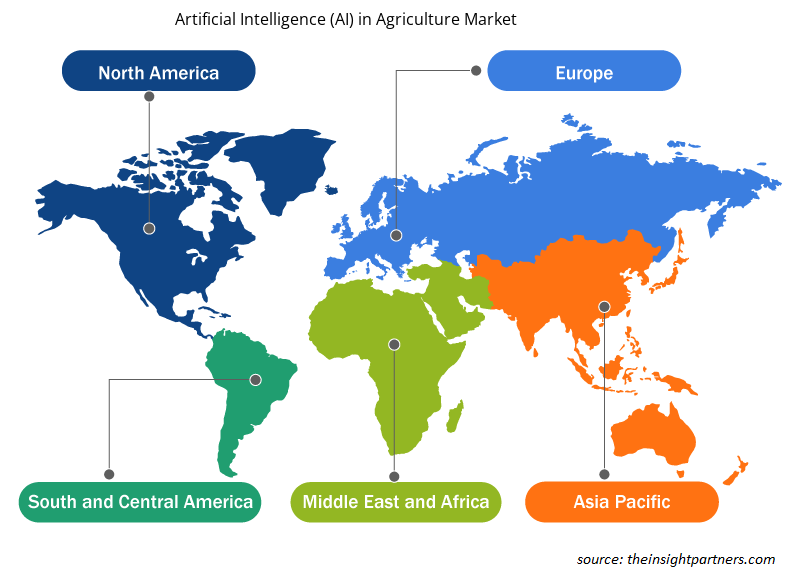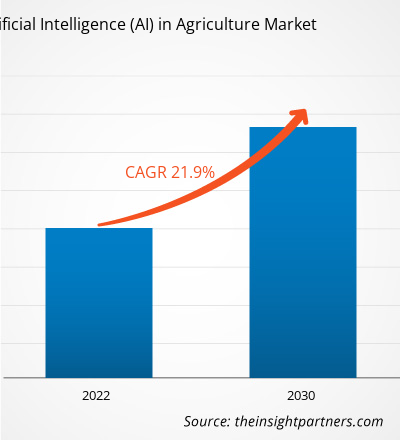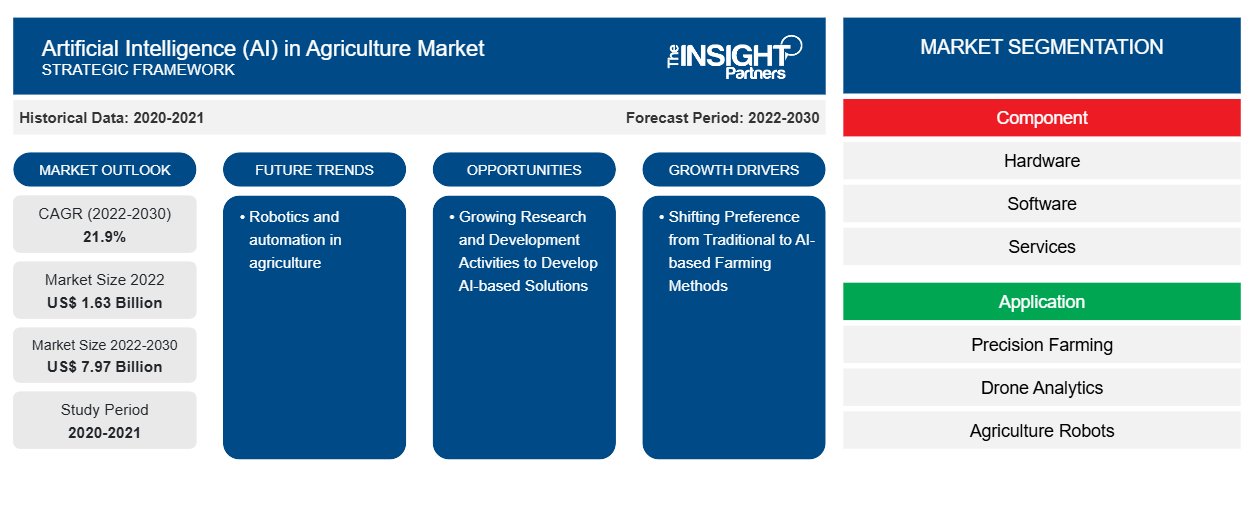Der Markt für künstliche Intelligenz (KI) in der Landwirtschaft hatte im Jahr 2022 einen Wert von 1,63 Milliarden US-Dollar und wird bis 2030 voraussichtlich 7,97 Milliarden US-Dollar erreichen; von 2022 bis 2030 wird eine durchschnittliche jährliche Wachstumsrate (CAGR) von 21,9 % erwartet. Robotik und Automatisierung in der Landwirtschaft werden voraussichtlich weiterhin wichtige Trends auf dem Markt bleiben.
Künstliche Intelligenz (KI) in der Landwirtschaft – Marktanalyse
Der Markt wird durch die Verschiebung der Präferenz von traditionellen zu KI-basierten landwirtschaftlichen Methoden, den zunehmenden Einsatz unbemannter Flugobjekte (UAVs) in der Landwirtschaft und den steigenden Bedarf an Echtzeitanalysen in der Landwirtschaft angetrieben. Aufgrund der zunehmenden staatlichen Unterstützung für die Implementierung von KI-Lösungen wird für den Prognosezeitraum ein Marktwachstum erwartet. Darüber hinaus schaffen wachsende Forschungs- und Entwicklungsaktivitäten zur Entwicklung KI-basierter Lösungen und die zunehmende intelligente Landwirtschaft lukrative Möglichkeiten für den Markt.
Künstliche Intelligenz (KI) in der Landwirtschaft – Marktübersicht
Künstliche Intelligenz (KI) revolutioniert die Landwirtschaft. Predictive Analytics, Computer Vision, maschinelles Lernen und Datenanalyse helfen der Landwirtschaft, Hindernisse zu überwinden und ihr volles Potenzial auszuschöpfen. Der Einsatz von KI in der Landwirtschaft ermöglicht die Erfassung und Analyse von Daten aus einer Vielzahl von Quellen, darunter Bodenbedingungen, Wettermuster, Pflanzengesundheit und historische Daten.
KI-basierte Systeme können Landwirten wertvolle Informationen liefern, um Erträge zu steigern, Abfälle zu reduzieren und Umweltprobleme zu minimieren. Landwirte und Interessenvertreter können datengesteuerte Erkenntnisse und intelligente Entscheidungsfindung nutzen, um die Produktivität zu steigern, die Ressourcennutzung zu optimieren und agronomische Probleme zu lösen. Intelligente Maschinen und Roboter können eingesetzt werden, um monotone Aufgaben in der Landwirtschaft zu automatisieren. Diese Fortschritte helfen landwirtschaftlichen Betrieben, den Arbeitskräftemangel zu beheben und sich auf strategische Planung und Management zu konzentrieren.
Passen Sie diesen Bericht Ihren Anforderungen an
Sie erhalten kostenlos individuelle Anpassungen an jedem Bericht, einschließlich Teilen dieses Berichts oder einer Analyse auf Länderebene, eines Excel-Datenpakets sowie tolle Angebote und Rabatte für Start-ups und Universitäten.
-
Holen Sie sich die wichtigsten Markttrends aus diesem Bericht.Dieses KOSTENLOSE Beispiel umfasst eine Datenanalyse von Markttrends bis hin zu Schätzungen und Prognosen.
Künstliche Intelligenz (KI) in der Landwirtschaft – Markttreiber und Chancen
Verschiebung der Präferenz von traditionellen zu KI-basierten landwirtschaftlichen Methoden
Traditionelle Kartoffelbauern in ganz Kanada stehen vor Herausforderungen im Nährstoffmanagement, einem entscheidenden Aspekt der Landwirtschaft, der sich direkt auf die Ernteerträge auswirkt. Die herkömmlichen Methoden der Bodenbehandlung und Blattdüngung sind zwar bis zu einem gewissen Grad wirksam, haben jedoch Einschränkungen, insbesondere bei Nährstoffen, die in späteren Phasen des Kartoffelwachstums benötigt werden. Daher setzen Kartoffelbauern in ganz Kanada KI-Lösungen ein, um den Nährstoffbedarf der Kartoffelpflanze vorherzusagen. Im November 2023 beispielsweise, mit bahnbrechenden Entwicklungen im Agrarsektor, greifen kanadische Kartoffelbauern auf KI zurück, um den Nährstoffbedarf ihrer Pflanzen in Echtzeit zu überwachen und vorherzusagen. Somit treibt die Einführung von KI durch kanadische Landwirte das Wachstum von KI im Agrarmarkt voran.
Wachsende Forschungs- und Entwicklungsaktivitäten zur Entwicklung KI-basierter Lösungen
Großbritannien verfügt über erstklassige Technologie und Forschungskapazitäten und ist weltweit führend in der Entwicklung von KI-gestützten Lösungen. Darüber hinaus nutzen britische Forscher KI, um traditionelle Branchen wie die Landwirtschaft zu revolutionieren. Daten vom Januar 2024 zufolge versuchen Forscher der Harper Adams University, die Landwirtschaft mithilfe von KI nachhaltiger und produktiver zu machen.
Die britische Regierung hat außerdem Fördermittel in Höhe von 39,82 Millionen US-Dollar angekündigt, um die Entwicklung von Projekten im Bereich künstliche Intelligenz in verschiedenen Sektoren wie Landwirtschaft, Mode und Rettungsdienste zu unterstützen. Weitere 5,38 Millionen US-Dollar wurden für Machbarkeitsstudien für 100 Projekte kleiner Unternehmen vergeben, um innovative KI-Ideen zur Steigerung der Produktivität in verschiedenen Sektoren zu fördern. Daher wird erwartet, dass diese staatliche Unterstützung das Wachstum der KI im Agrarmarkt vorantreibt.
Künstliche Intelligenz (KI) in der Landwirtschaft Marktbericht Segmentierungsanalyse
Wichtige Segmente, die zur Ableitung der Marktanalyse künstlicher Intelligenz (KI) in der Landwirtschaft beigetragen haben , sind Komponenten und Anwendungen.
- Basierend auf den Komponenten wird der Markt für künstliche Intelligenz (KI) im Agrarbereich in Hardware, Software und Dienstleistungen unterteilt. Das Hardwaresegment hatte im Jahr 2022 einen größeren Marktanteil.
- In Bezug auf die Anwendung ist der Markt in Präzisionslandwirtschaft , Drohnenanalytik, Landwirtschaftsroboter, Viehüberwachung und andere unterteilt. Das Segment Präzisionslandwirtschaft hatte im Jahr 2022 einen größeren Marktanteil.
Künstliche Intelligenz (KI) in der Landwirtschaft – Marktanteilsanalyse nach Geografie
Der geografische Umfang des Marktberichts über künstliche Intelligenz (KI) in der Landwirtschaft ist hauptsächlich in fünf Regionen unterteilt: Nordamerika, Asien-Pazifik, Europa, Naher Osten und Afrika sowie Süd- und Mittelamerika.
Der Markt im asiatisch-pazifischen Raum wird im Prognosezeitraum voraussichtlich wachsen, da die Nachfrage nach technologisch fortschrittlichen Lösungen steigt. In Ländern wie Australien, wo die landwirtschaftliche Belegschaft schnell altert, ist die Nachfrage nach Fachkräften größer denn je. Die Landwirtschaft mit ihrer Integration modernster Technologien wie KI und maschinellem Lernen ist der Schlüssel, um diese Lücke zu schließen und die Landwirtschaft in die Gegenwart zu bringen. Mehrere australische Landwirte profitieren bereits von den Vorteilen KI-gestützter Systeme. So setzte Sunray Strawberries in Wamuran im Oktober 2023 das automatisierte Überwachungssystem DeepBerry ein. Das System verwendet sowohl visuelle als auch Infrarotbilder, um Reife, Druckstellen, Pilzbefall, Fruchtgröße, -form und Fremdkörper genau zu erkennen. Es kann mehr als 7.000 Spritznetze pro Stunde verarbeiten. Die Implementierung solcher automatisierter Systeme treibt das Wachstum von KI im Agrarmarkt voran.
Künstliche Intelligenz (KI) im Agrarmarkt – regionale Einblicke
Die regionalen Trends und Faktoren, die den Markt für künstliche Intelligenz (KI) in der Landwirtschaft während des gesamten Prognosezeitraums beeinflussen, wurden von den Analysten von Insight Partners ausführlich erläutert. In diesem Abschnitt werden auch Marktsegmente und Geografien für künstliche Intelligenz (KI) in der Landwirtschaft in Nordamerika, Europa, im asiatisch-pazifischen Raum, im Nahen Osten und Afrika sowie in Süd- und Mittelamerika erörtert.

- Erhalten Sie regionalspezifische Daten zum Markt für künstliche Intelligenz (KI) im Agrarbereich
Umfang des Marktberichts über künstliche Intelligenz (KI) in der Landwirtschaft
| Berichtsattribut | Details |
|---|---|
| Marktgröße im Jahr 2022 | 1,63 Milliarden US-Dollar |
| Marktgröße bis 2030 | 7,97 Milliarden US-Dollar |
| Globale CAGR (2022-2030) | 21,9 % |
| Historische Daten | 2020-2021 |
| Prognosezeitraum | 2022–2030 |
| Abgedeckte Segmente |
Nach Komponente
|
| Abgedeckte Regionen und Länder |
Nordamerika
|
| Marktführer und wichtige Unternehmensprofile |
|
Künstliche Intelligenz (KI) in der Landwirtschaft – Marktteilnehmerdichte: Auswirkungen auf die Geschäftsdynamik verstehen
Der Markt für künstliche Intelligenz (KI) in der Landwirtschaft wächst rasant. Dies wird durch die steigende Nachfrage der Endnutzer aufgrund von Faktoren wie sich entwickelnden Verbraucherpräferenzen, technologischen Fortschritten und einem größeren Bewusstsein für die Vorteile des Produkts vorangetrieben. Mit der steigenden Nachfrage erweitern Unternehmen ihr Angebot, entwickeln Innovationen, um die Bedürfnisse der Verbraucher zu erfüllen, und nutzen neue Trends, was das Marktwachstum weiter ankurbelt.
Die Marktteilnehmerdichte bezieht sich auf die Verteilung der Firmen oder Unternehmen, die in einem bestimmten Markt oder einer bestimmten Branche tätig sind. Sie gibt an, wie viele Wettbewerber (Marktteilnehmer) in einem bestimmten Marktraum im Verhältnis zu seiner Größe oder seinem gesamten Marktwert präsent sind.
Die wichtigsten Unternehmen auf dem Markt für künstliche Intelligenz (KI) in der Landwirtschaft sind:
- Tule Technologies Inc
- PrecisionHawk Inc
- Easytosee Agtech SL
- Deere & Co
- Klima LLC
- Gamaya SA
Haftungsausschluss : Die oben aufgeführten Unternehmen sind nicht in einer bestimmten Reihenfolge aufgeführt.

- Überblick über die wichtigsten Akteure des Marktes für künstliche Intelligenz (KI) in der Landwirtschaft
Künstliche Intelligenz (KI) in der Landwirtschaft – Marktnachrichten und aktuelle Entwicklungen
Der Markt für künstliche Intelligenz (KI) im Agrarbereich wird durch die Erhebung qualitativer und quantitativer Daten nach Primär- und Sekundärforschung bewertet, die wichtige Unternehmensveröffentlichungen, Verbandsdaten und Datenbanken umfasst. Nachfolgend sind einige der Entwicklungen auf dem Markt für künstliche Intelligenz (KI) im Agrarbereich aufgeführt:
- Chipotle Mexican Grill gab Minderheitsbeteiligungen an Greenfield Robotics und Nitricity bekannt. Die Investition von Chipotle wird Greenfield Robotics helfen, seine Flotte zu erweitern und zusätzliche Fähigkeiten für seine Roboter zu entwickeln, wie etwa Mikrosprühen, Anbau von Zwischenfrüchten und Bodentests. (Quelle: Chipotle Mexican Grill, Unternehmenswebsite, Dezember 2023).
Künstliche Intelligenz (KI) in der Landwirtschaft – Marktbericht – Umfang und Ergebnisse
Der Bericht „Marktgröße und Prognose für künstliche Intelligenz (KI) in der Landwirtschaft (2020–2030)“ bietet eine detaillierte Analyse des Marktes, die die folgenden Bereiche abdeckt:
- Künstliche Intelligenz (KI) in der Landwirtschaft – Marktgröße und Prognose auf globaler, regionaler und Länderebene für alle wichtigen Marktsegmente, die im Rahmen des Projekts abgedeckt sind
- Künstliche Intelligenz (KI) in der Landwirtschaft – Markttrends sowie Marktdynamiken wie Treiber, Einschränkungen und wichtige Chancen
- Detaillierte PEST/Porters Five Forces- und SWOT-Analyse
- Marktanalyse für künstliche Intelligenz (KI) in der Landwirtschaft, die wichtige Markttrends, globale und regionale Rahmenbedingungen, wichtige Akteure, Vorschriften und aktuelle Marktentwicklungen umfasst
- Branchenlandschaft und Wettbewerbsanalyse, die die Marktkonzentration, Heatmap-Analyse, prominente Akteure und aktuelle Entwicklungen für den Markt für künstliche Intelligenz (KI) in der Landwirtschaft umfasst
- Detaillierte Firmenprofile
- Historische Analyse (2 Jahre), Basisjahr, Prognose (7 Jahre) mit CAGR
- PEST- und SWOT-Analyse
- Marktgröße Wert/Volumen – Global, Regional, Land
- Branchen- und Wettbewerbslandschaft
- Excel-Datensatz
Aktuelle Berichte
Erfahrungsberichte
Grund zum Kauf
- Fundierte Entscheidungsfindung
- Marktdynamik verstehen
- Wettbewerbsanalyse
- Kundeneinblicke
- Marktprognosen
- Risikominimierung
- Strategische Planung
- Investitionsbegründung
- Identifizierung neuer Märkte
- Verbesserung von Marketingstrategien
- Steigerung der Betriebseffizienz
- Anpassung an regulatorische Trends























 Kostenlose Probe anfordern für - Künstliche Intelligenz (KI) im Agrarmarkt
Kostenlose Probe anfordern für - Künstliche Intelligenz (KI) im Agrarmarkt